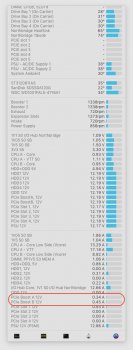Hi!
Couldn't find anything like this in a few searches here or on Google. Just flashed an EVGA GTX 680 (using the guide found on this site, THANKS!) and everything works great except it doesn't look like it is pulling power from both 6 pin connectors on the logic board. iStat shows PCIe Boost B with an fluctuating amperage draw based on load but PCIe Boost A shows a flatline reading of 0ma. Is this something to be concerned about or is iStat just not reporting info correctly?
Benchmarks
LuxMark 3.1 Ball - 5190
Geekbench OpenCL - 51867
Geekbench Metal - 66163
Scores appear to be in the right ballpark and the system is stable, just wondering if anyone else has stumbled across something similar to what I'm experiencing.
Thanks!
Couldn't find anything like this in a few searches here or on Google. Just flashed an EVGA GTX 680 (using the guide found on this site, THANKS!) and everything works great except it doesn't look like it is pulling power from both 6 pin connectors on the logic board. iStat shows PCIe Boost B with an fluctuating amperage draw based on load but PCIe Boost A shows a flatline reading of 0ma. Is this something to be concerned about or is iStat just not reporting info correctly?
Benchmarks
LuxMark 3.1 Ball - 5190
Geekbench OpenCL - 51867
Geekbench Metal - 66163
Scores appear to be in the right ballpark and the system is stable, just wondering if anyone else has stumbled across something similar to what I'm experiencing.
Thanks!




